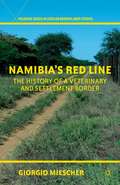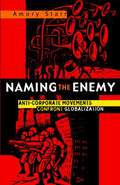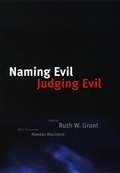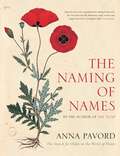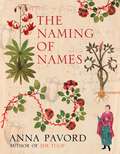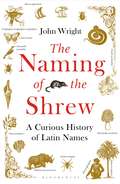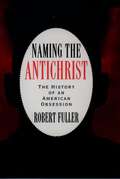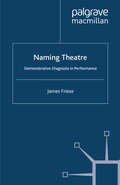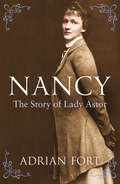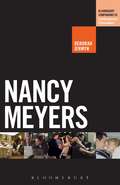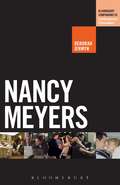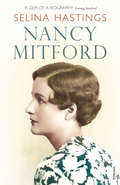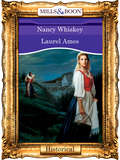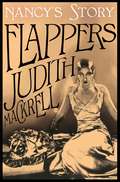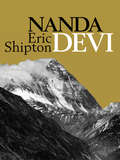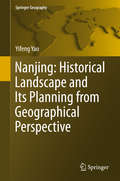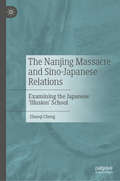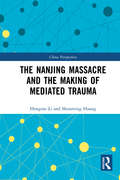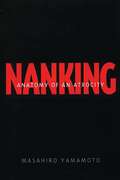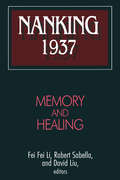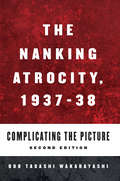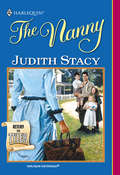- Table View
- List View
Namibia's Red Line: The History of a Veterinary and Settlement Border (Palgrave Series in African Borderlands Studies)
by G. MiescherBased on archival sources and oral history, this book reconstructs a border-building process in Namibia that spanned more than sixty years. The process commenced with the establishment of a temporary veterinary defence line against rinderpest by the German colonial authorities in the late nineteenth century and ended with the construction of a continuous two-metre-high fence by the South African colonial government sixty years later. This 1250-kilometre fence divides northern from central Namibia even today. The book combines a macro and a micro-perspective and differentiates between cartographic and physical reality. The analysis explores both the colonial state's agency with regard to veterinary and settlement policies and the strategies of Africans and Europeans living close to the border. The analysis also includes the varying perceptions of individuals and populations who lived further north and south of the border and describes their experiences crossing the border as migrant workers, African traders, European settlers and colonial officials. The Red Line's history is understood as a gradual process of segregating livestock and people, and of constructing dichotomies of modern and traditional, healthy and sick, European and African.
Naming The Enemy: Anti-corporate Movements Confront Globalization (PDF)
by Amory StarrA new movement of 'anti-globalists', in Time Magazine's words (24 April 2000), now 'oppose corporate dominion over the planet's poor and disfranchised'. Naming the Enemy is the first systematic documentation of this international resistance to transnational corporations and globalization which has so recently burst into the public gaze with the street protests in Seattle, Washington, London and Prague. A wide and heterogeneous range of social movements now oppose the very fundamentals of market capitalism. Their challenge is beginning, Amory Starr shows, to amount to a sweeping critique of its purposes and practice. She explains how these movements understand their enemies and what sort of future they envision. There are, she suggests, three basic types: Movements trying to constrain corporate power through democratic institutions and direct action; Movements attempting a completely different kind of 'globalization from below' in which corporations will be reshaped in the service of new international democratic structures that will be populist, participatory and just; Movements seeking to delink their localities and communities from the global economy and rebuild instead small-scale socieites in which large corporations have no role at all. This new phenomenon has received scant media or scholarly attention. But it is likely to become much more important politically as the globalized economy dominated by giant corporations and institutions like the World Bank and IMF fails to deliver on jobs, social justice, Third World development and the environment. The course of this new kind of political struggle will have huge implications for human welfare and civil liberties. This unique and important book is relevant to activists as well as students and scholars of globalization, new social movements and political economy.
Naming Evil, Judging Evil (Center For American Places - Center Books On American Places Ser.)
by Ruth W. Grant Alasdair MacIntyreIs it more dangerous to call something evil or not to? This fundamental question deeply divides those who fear that the term oversimplifies grave problems and those who worry that, to effectively address such issues as terrorism and genocide, we must first acknowledge them as evil. Recognizing that the way we approach this dilemma can significantly affect both the harm we suffer and the suffering we inflict, a distinguished group of contributors engages in the debate with this series of timely and original essays. Drawing on Western conceptions of evil from the Middle Ages to the present, these pieces demonstrate that, while it may not be possible to definitively settle moral questions, we are still able—and in fact are obligated—to make moral arguments and judgments. Using a wide variety of approaches, the authors raise tough questions: Why is so much evil perpetrated in the name of good? Could evil ever be eradicated? How can liberal democratic politics help us strike a balance between the need to pass judgment and the need to remain tolerant? Their insightful answers exemplify how the sometimes rarefied worlds of political theory, philosophy, theology, and history can illuminate pressing contemporary concerns.
Naming Evil, Judging Evil (Center For American Places - Center Books On American Places Ser.)
by Ruth Weissbourd Grant Alasdair MacIntyreIs it more dangerous to call something evil or not to? This fundamental question deeply divides those who fear that the term oversimplifies grave problems and those who worry that, to effectively address such issues as terrorism and genocide, we must first acknowledge them as evil. Recognizing that the way we approach this dilemma can significantly affect both the harm we suffer and the suffering we inflict, a distinguished group of contributors engages in the debate with this series of timely and original essays. Drawing on Western conceptions of evil from the Middle Ages to the present, these pieces demonstrate that, while it may not be possible to definitively settle moral questions, we are still able—and in fact are obligated—to make moral arguments and judgments. Using a wide variety of approaches, the authors raise tough questions: Why is so much evil perpetrated in the name of good? Could evil ever be eradicated? How can liberal democratic politics help us strike a balance between the need to pass judgment and the need to remain tolerant? Their insightful answers exemplify how the sometimes rarefied worlds of political theory, philosophy, theology, and history can illuminate pressing contemporary concerns.
The Naming of Names: The Search for Order in the World of Plants
by Anna PavordFor centuries, some of the most brilliant minds in Europe searched for the rules of nature's game. In a world full of plagues and poisons, many medicines were made from plant extracts and there was a practical need to differentiate between one plant and another. Alongside this was an overwhelming desire to make sense of the natural world. Scholars, aided by the artists who painted the first pictures of plants, set out looking, writing and classifying, but 2,000 years were to pass before any rules became clear. Anna Pavord takes us on an exhilarating and fascinating journey through botanical history, travelling from Athens in the third century BC, through Constantinople and Venice, Padua and Pisa to the present day.
The Naming of Names: The Search for Order in the World of Plants
by Anna PavordThe Naming of Names traces the search for order in the natural world, a search that for hundreds of years occupied some of the most brilliant minds in Europe, reaching its apex during the renaissance. Anna Pavord takes us on a thrilling adventure into botanical history, travelling from Athens in the third century BC, through Constantinople, Venice, the medical school at Salerno to the universities of Pisa and Padua. The journey, traced here for the first time, involves the culture of Islam, the first expeditions to the Indies and the first settlers in the New World. Gradually, over a long period in Europe, plants assumed identities and acquired names. Artists painted the first pictures of them. Plants acquired the two-part names that show how they are related to other plants. But who began all this work, and how was it done? Sumptuously illustrated in full colour, The Naming of Names gives a compelling insight into a world full of intrigue and intensely competitive egos.
The Naming of the Shrew: A Curious History of Latin Names
by John WrightLatin names – frequently unpronounceable, all too often wrong and always a tiny puzzle to unravel – have been annoying the layman since they first became formalised as scientific terms in the eighteenth century. Why on earth has the entirely land-loving Eastern Mole been named Scalopus aquaticus, or the Oxford Ragwort been called Senecio squalidus – 'dirty old man'? What were naturalists thinking when they called a beetle Agra katewinsletae, a genus of fish Batman, and a Trilobite Han solo? Why is zoology replete with names such as Chloris chloris chloris (the greenfinch), and Gorilla gorilla gorilla (a species of, well gorilla)?The Naming of the Shrew will unveil these mysteries, exploring the history, celebrating their poetic nature and revealing how naturalists sometimes get things so terribly wrong. With wonderfully witty style and captivating narrative, this book will make you see Latin names in a whole new light.
Naming the Antichrist: The History of an American Obsession
by Robert C. FullerThe Antichrist, though mentioned a mere four times in the Bible, and then only obscurely, has exercised a tight hold on popular imagination throughout history. This has been particularly true in the U.S., says author Robert C. Fuller, where Americans have tended to view our nation as uniquely blessed by God--a belief that leaves us especially prone to demonizing our enemies. In Naming the Antichrist, Fuller takes us on a fascinating journey through the dark side of the American religious psyche, from the earliest American colonists right up to contemporary fundamentalists such as Pat Robertson and Hal Lindsey. Fuller begins by offering a brief history of the idea of the Antichrist and its origins in the apocalyptic thought in the Judeo-Christian tradition, and traces the eventual 71Gws how the colonists saw Antichrist personified in native Americans and French Catholics, in Anne Hutchinson, Roger Williams, and the witches of Salem, in the Church of England and the King. He looks at the Second Great Awakening in the early nineteenth century, showing how such prominent Americans as Yale president Timothy Dwight and the Reverend Jedidiah Morse (father of Samuel Morse) saw the work of the Antichrist in phenomena ranging from the French Revolution to Masonry. In the twentieth century, he finds a startling array of hate-mongers--from Gerald Winrod (who vilified Roosevelt as a pawn of the Antichrist) to the Ku Klux Klan--who drew on apocalyptic imagery in their attacks on Jews, Catholics, blacks, socialists, and others. Finally, Fuller considers contemporary fundamentalist writers such as Hal Lindsey (author of The Late Great Planet Earth, with some 19 million copies sold), Mary Stewart Relfe (whose candidates for the Antichrist have included such figures as Henry Kissinger, Pope John Paul II, and Anwar Sadat), and a host of others who have found Antichrist in the sinister guise of the European Economic Community, the National Council of Churches, feminism, New Age religions, and even supermarket barcodes and fibre optics (the latter functioning as "the eye of the Antichrist"). Throughout, Fuller reveals in vivid detail how our unique American obsession with the Antichrist reflects the struggle to understand ourselves--and our enemies--within the mythic context of the battle of absolute good versus absolute evil. From the Scofield Reference Bible (no other book had greater impact on the American Antichrist tradition) to the Scopes Monkey Trial, Fuller provides an informative and often startling look at a thread that weaves persistently throughout American religious and cultural life.
Naming Theatre: Demonstrative Diagnosis in Performance (Performance Interventions)
by J. FriezeReading a range of work from the US and UK over the last two decades, this is an innovative study of theatre's growing obsession with technologies and effects of naming. How does theatre reflect, and intervene in, naming practices across domains such as philosophy, computing, journalism, anthropology, advertising, military training, and genetics?
Nancy: The Story Of Lady Astor
by Adrian FortIn 1919, Nancy Astor became the first woman to take a seat in parliament.She was not what had been expected. Far from a virago who had suffered for the cause of female suffrage, she was already near the centre of the ruling society that had for so long resisted the political upheavals of the early twentieth century, having married into the family of one of the richest men in the world. She was not even British. She would prove to be a trailblazer and beacon for the generations of women who would follow her into Parliament.This new biography charts Nancy Astor's incredible story, from penury in the American South, to a lifestyle of the most immense riches, from the luxury of Edwardian England, through the 'Jazz Age', and on towards the Second World War: a world of great country estates, lavish town houses and the most sumptuous entertainments, peopled by the most famous and powerful names of the age. But hers was not only the life of power, glamour and easy charm: it was also defined by principles and bravery, by war and sacrifice, by love and bitter disputes. With glorious, page-turning brio, Adrian Fort has brought to life this restless, controversial American dynamo, an unforgettable woman who left a deep and lasting imprint on the political life of our nation.
Nancy Meyers (The Bloomsbury Companions to Contemporary Filmmakers)
by Deborah JermynNancy Meyers is acknowledged as the most commercially successful woman filmmaker of all time, described by Daphne Merkin in The New York Times on the release of It's Complicated as "a singular figure in Hollywood – [she] may, in fact, be the most powerful female writer-director-producer currently working". Yet Meyers remains a director who, alongside being widely dismissed by critics, has been largely absent in scholarly accounts both of contemporary Hollywood cinema, and of feminism and film. Despite Meyers' impressive track record for turning a profit (including the biggest box-office return ever achieved by a woman filmmaker at that timefor What Women Want in 2000), and a multifaceted career as a writer/producer/director dating back to her co-writing Private Benjamin in 1980, Meyers has been oddly neglected by Film Studies to date. Including Nancy Meyers in the Bloomsbury Companions to Contemporary Filmmakers rectifies this omission, giving her the kind of detailed consideration and recognition she warrants and exploring how, notwithstanding the challenges authorship holds for feminist film studies, Meyers can be situated as a skilled 'auteur'. This book proposes that Meyers' box-office success, the consistency of style and theme across her films, and the breadth of her body of work as a writer/producer/director across more than three decades at the forefront of Hollywood, (thus importantly bridging the second/third waves of feminism) make her a key contemporary US filmmaker. Structured to meet the needs of both the student and scholar, Jermyn's volume situates Meyers within this historical and critical context, exploring the distinctive qualities of her body of work, the reasons behind the pervasive resistance to it and new ways of understanding her films.
Nancy Meyers (The Bloomsbury Companions to Contemporary Filmmakers)
by Deborah JermynNancy Meyers is acknowledged as the most commercially successful woman filmmaker of all time, described by Daphne Merkin in The New York Times on the release of It's Complicated as "a singular figure in Hollywood – [she] may, in fact, be the most powerful female writer-director-producer currently working". Yet Meyers remains a director who, alongside being widely dismissed by critics, has been largely absent in scholarly accounts both of contemporary Hollywood cinema, and of feminism and film. Despite Meyers' impressive track record for turning a profit (including the biggest box-office return ever achieved by a woman filmmaker at that timefor What Women Want in 2000), and a multifaceted career as a writer/producer/director dating back to her co-writing Private Benjamin in 1980, Meyers has been oddly neglected by Film Studies to date. Including Nancy Meyers in the Bloomsbury Companions to Contemporary Filmmakers rectifies this omission, giving her the kind of detailed consideration and recognition she warrants and exploring how, notwithstanding the challenges authorship holds for feminist film studies, Meyers can be situated as a skilled 'auteur'. This book proposes that Meyers' box-office success, the consistency of style and theme across her films, and the breadth of her body of work as a writer/producer/director across more than three decades at the forefront of Hollywood, (thus importantly bridging the second/third waves of feminism) make her a key contemporary US filmmaker. Structured to meet the needs of both the student and scholar, Jermyn's volume situates Meyers within this historical and critical context, exploring the distinctive qualities of her body of work, the reasons behind the pervasive resistance to it and new ways of understanding her films.
Nancy Mitford
by Selina HastingsNancy Mitford was witty, intelligent, often acerbic, a great tease and an acute observer of upper-class English idiosyncrasies. With the publication of her novels, above all The Pursuit of Love, Love in a Cold Climate and The Blessing, she became a huge bestseller and a household name. An inspired letter writer, she wrote almost daily to a wide variety of correspondents, among them Evelyn Waugh, Harold Action, John Betjeman, Lord Berners, Lady Seafield, and, of course, her sisters. Selina Hastings captures equally the gaiety and frivolity and the unhappy truth of Nancy Mitford's life: her failed marriage and her long, unfulfilled relationship with 'the Colonel' contrasting sharply with literary celebrity and glittering social success. Selina Hastings has written a biography that is superbly entertaining and clear-eyed, of a life that Diana Mosley spoke of as being 'so sad one can hardly bear to contemplate it'.
Nancy Whiskey (Mills And Boon Vintage 90s Modern Ser.)
by Laurel AmesNancy Riley Had Finally Found Her Destiny In Daniel Tallent, the man of her dreams. A man of dangerous secrets whose appeal rivaled the adventure and excitement of the American wilderness they traveled, and whose passion matched her own, newfound desire.
Nancy's Story: Women Of A Dangerous Generation (Flappers #3)
by Judith MackrellGlamorized, mythologized and demonized – the women of the 1920s prefigured the 1960s in their determination to reinvent the way they lived. Flappers is in part a biography of that restless generation: starting with its first fashionable acts of rebellion just before the Great War, and continuing through to the end of the decade when the Wall Street crash signalled another cataclysmic world change. Nancy Cunard, Diana Cooper, Tallulah Bankhead, Zelda Fitzgerald, Josephine Baker and Tamara de Lempicka were far from typical flappers. Although they danced the Charleston, wore fashionable clothes and partied with the rest of their peers, they made themselves prominent among the artists, icons, and heroines of their age. Talented, reckless and wilful, with personalities that transcended their class and background, they re-wrote their destinies in remarkable, entertaining and tragic ways. And between them they blazed the trail of the New Woman around the world. Nancy’s Story is extracted from Judith Mackrell’s acclaimed biography, Flappers: Six Women of a Dangerous Generation.
Nanda Devi: Nanda Davi Exploration And Ascent (Nanda Davi Exploration and Ascent #1)
by Eric Shipton'When a man is conscious of the urge to explore, not all the arduous journeyings, the troubles that will beset him and the lack of material gains from his investigations will stop him.' Nanda Devi is one of the most inaccessible mountains in the Himalaya. It is surrounded by a huge ring of peaks, among them some of the highest mountains in the Indian Himalaya. For fifty years the finest mountaineers of the early twentieth century had repeatedly tried and failed to reach the foot of the mountain. Then, in 1934, Eric Shipton and H. W. Tilman found a way in. Their 1934 expedition is regarded as the epitome of adventurous mountain exploration. With their three tough and enthusiastic Sherpa companions Angtharkay, Kusang and Pasang, they solved the problem of access to the Nanda Devi Sanctuary. They crossed difficult cols, made first ascents and explored remote, uninhabited valleys, all of which is recounted in Shipton's wonderfully vivid Nanda Devi - a true evocation of Shipton's enduring spirit of adventure and one of the most inspirational travel books ever written.
Nanjing: Historical Landscape and Its Planning from Geographical Perspective (Springer Geography)
by Yifeng YaoThis book studies the historical changes of the cityscape of Nanjing from the point of view of geographical systems. Nanjing is a city located along the Yangtze River, originated 2500 years ago, after which ten dynasties established their capital dependent on the geographical conditions. The book focuses on the analysis of the characteristics of mountain and river systems in the various historical periods, and provides investigations of historical sites along with these systems. This enables the search for the laws of historical evolution and spatial structure changes, which is also the research of the relationship between man and nature. It extends the traditional preservation and cityscapes planning to that of geographical landscape system. Readers working in the area of geography, history, urban and landscape planning will benefit from it.
The Nanjing Massacre and Sino-Japanese Relations: Examining the Japanese 'Illusion' School
by Zhaoqi ChengBased on extensive research on the International Military Tribunal for the Far East, this book closely examines the claims and controversy surrounding the ‘Nanjing Massacre’, a period of murder in 1937-1938 committed by Japanese troops against the residents of Nanjing (Nanking), after the capture of the then capital of the Republic of China, during the Second Sino-Japanese War. Focusing on weighing up arguments denying Nanjing Massacre, this book considers the Japanese ‘Illusion’ school of thought which contests the truth of the Nanjing Massacre claims, including the death toll and the scale of the violence. The Nanjing Massacre remains a controversial issue in Sino-Japanese relations, despite the normalization of bilateral relations, and this book goes to great lengths to examine the events through comparative narratives, investigating different perspectives and contributings to the debate from the extensive research of the Tokyo Trial Research Centre at Shanghai, as well as volumes of Chinese and Japanese historical documents.
The Nanjing Massacre and the Making of Mediated Trauma (China Perspectives)
by Hongtao Li Shunming HuangDrawing on cultural trauma theory, this book investigates how collective memory of the Nanjing Massacre is fashioned in China and how the mass media, political power and public praxis jointly shape the politics and culture of memory in contemporary China. Allowing for the dimensions of history and different mediating spaces, the authors first conduct textual analysis of news reports from traditional media since the event took place, revealing that the significance of the Massacre was initially portrayed as a local incident before its construction as a national trauma and finally a collective memory. In a study of physical and online memorial spaces, including the Memorial Hall, commemorative activities on the Internet and new media platforms, the book unveils the production and reproduction of trauma narratives as well as how these narratives have been challenged. The final part further studies the interactions between media and other institutional settings while exploring issues of global memory and reconciliation in East Asia. The title will be an essential read for anyone interested in memory studies, media and communication, and particularly the collective memory of the Nanjing Massacre.
The Nanjing Massacre and the Making of Mediated Trauma (China Perspectives)
by Hongtao Li Shunming HuangDrawing on cultural trauma theory, this book investigates how collective memory of the Nanjing Massacre is fashioned in China and how the mass media, political power and public praxis jointly shape the politics and culture of memory in contemporary China. Allowing for the dimensions of history and different mediating spaces, the authors first conduct textual analysis of news reports from traditional media since the event took place, revealing that the significance of the Massacre was initially portrayed as a local incident before its construction as a national trauma and finally a collective memory. In a study of physical and online memorial spaces, including the Memorial Hall, commemorative activities on the Internet and new media platforms, the book unveils the production and reproduction of trauma narratives as well as how these narratives have been challenged. The final part further studies the interactions between media and other institutional settings while exploring issues of global memory and reconciliation in East Asia. The title will be an essential read for anyone interested in memory studies, media and communication, and particularly the collective memory of the Nanjing Massacre.
Nanking: Anatomy of an Atrocity
by Masahiro YamamotoThe December 1937 incident that has come to be known as the Rape of Nanking is, without doubt, a tragedy that will not soon be forgotten. While acknowledging that a tremendous loss of life occurred, this study challenges the current prevailing notion that the incident was a deliberate, planned effort on the part of the Japanese military and analyzes events to produce an accurate estimate of the scale of the atrocities. Drawing on Chinese, Japanese, and English sources, Yamamoto determines that what happened at Nanking were unfortunate atrocities of conventional war with precedents in both Eastern and Western military history. He concludes that post-war events such as the war crimes trials and the impact of the Holocaust in Europe affected public opinion regarding Nanking and led to a dramatic reinterpretation of events.The Rape of Nanking consisted of two distinct phases: the mass execution of prisoners of war (as well as conscription age men who appeared to be combatants) and the delinquent acts of individual soldiers. The first phase, which occurred immediately after Nanking's fall and which claimed most of the atrocity victims, was the result of the Japanese military's attempt to clear the city of Chinese soldiers thought to be in plain clothes. The second phase, which lasted approximately six weeks, was horrible, but resulted in a much smaller number of fatalities. It was characterized by numerous criminal acts, ranging from rape and murder to arson and theft, committed by unrestrained Japanese soldiers. The root cause for both phases was the Japanese military's bureaucratic inefficiency and command irresponsibility. While both Chinese and American contemporary sources initially attributed the incident to these causes, subsequent Japanese atrocities against both military and civilian Allied personnel during World War II and evidence presented at war crimes trials would come to reshape perceptions of the Nanking events as an Asian counterpart to the Nazi Holocaust.
Nanking 1937: Memory and Healing
by Feifei Li David Liu Robert SabellaIn recent years the international community has begun to scrutinize and, in many cases, condemn the atrocities that took place at Nanking in late 1937. This is all part of a larger worldwide movement in which both nations and multinational groups are attempting to reach closure regarding past atrocities and inhumanities. As represented by the contributors to this book, these activities have an importance reaching far beyond aggressors or victims, beyond admission or vindication, but rather are a search for the common causes of all human atrocities and for solutions that would set humanity on a path toward a more peaceful and harmonious international community.
Nanking 1937: Memory and Healing
by Feifei Li David Liu Robert SabellaIn recent years the international community has begun to scrutinize and, in many cases, condemn the atrocities that took place at Nanking in late 1937. This is all part of a larger worldwide movement in which both nations and multinational groups are attempting to reach closure regarding past atrocities and inhumanities. As represented by the contributors to this book, these activities have an importance reaching far beyond aggressors or victims, beyond admission or vindication, but rather are a search for the common causes of all human atrocities and for solutions that would set humanity on a path toward a more peaceful and harmonious international community.
The Nanking Atrocity, 1937-1938: Complicating the Picture
by Bob Tadashi WakabayashiFirst published in 2007, The Nanking Atrocity remains an essential resource for understanding the massacre committed by Japanese soldiers in Nanking, China during the winter of 1937-38. Through a series of deeply considered and empirically rigorous essays, it provides a far more complex and nuanced perspective than that found in works like Iris Chang’s bestselling The Rape of Nanking. It systematically reveals the flaws and exaggerations in Chang’s book while deflating the self-exculpatory narratives that persist in Japan even today. This second edition includes an extensive new introduction by the editor reflecting on the historiographical developments of the last decade, in advance of the 80th anniversary of the massacre.
The Nanny (Mills And Boon Historical Ser.)
by Judith StacyHoly Terrors, The Lot Of 'Em! That's what everyone considered Josh Ingalls's unruly passel of kids–secretly, anyway. No sense offending the most eligible widower in town! But Annie Martin didn't care what a "catch" her employer was. She only wanted him to admit he loved his children. And possibly share a kiss or two–okay, maybe three…!
